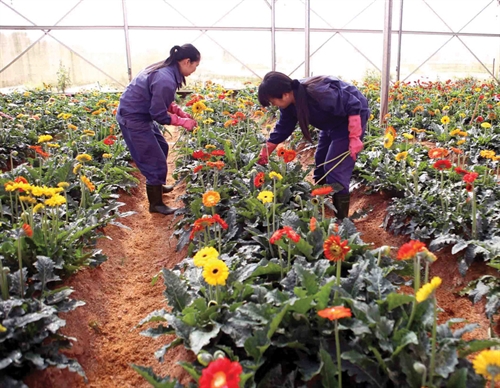
The revised Law on Technology Transfer (the Law), which was passed in June, is expected to create a solid legal basis to promote technology transfer, technology innovation, commercialization of scientific research and technological development results, and application of latest science and technology advances.
The revised Law on Technology Transfer (the Law), which was passed in June, is expected to create a solid legal basis to promote technology transfer, technology innovation, commercialization of scientific research and technological development results, and application of latest science and technology advances.
 |
| Transfer of flower-growing technology at Lam Dong province’s Center for Research and Application of Agricultural Techniques__Photo: Vu Sinh/VNA |
The Law introduces policies for different channels of technology transfer: transfer from abroad into the country, transfer from the country to abroad and transfer within the country. It also adds policies to prevent and abolish obsolete technologies and technologies that adversely affect socio-economic development, national defense, security, environment and human health.
Compared to the current Law on Technology Transfer enacted in 2006, the Law has significant changes.
Transferable technologies
Under Article 4, transferable technologies include:
- Technical and technological knowhows;
- Technological plans or processes; technical solutions, specifications, drawings and diagrams; formulas, computer software and data;
- Solutions to rationalize production or innovate technologies;
- Machinery and equipment accompanying one of the above mentioned objects.
The Law has revised criteria for defining technologies encouraged for transfer, technologies restricted from transfer and technologies banned from transfer. Specifically, criteria for defining technologies encouraged for transfer have been revised suitable to the current situation and conditions of socio-economic development. Technologies and machinery and equipment accompanying technologies which are no longer popularly used in industrially developed countries will be restricted from transfer from abroad into Vietnam and within Vietnam. Technologies and machinery and equipment accompanying technologies which are no longer popularly used and transferred in developing countries and do not satisfy national standards and technical regulations will be banned from transfer from abroad into Vietnam and within Vietnam.
The Government will issue specific lists of technologies encouraged for transfer, restricted from and banned from transfer, the Law says.
To avoid transfer pricing in technology transfer activities, the Law has made stricter provisions on transfer of technologies outside the lists of technologies restricted from or banned from transfer. Article 31 deals with the compulsory registration of technology transfer, which also aims to prevent the import of alike technologies.
Appraisal of technologies
The Law adds a separate chapter, Chapter II, on appraisal of technologies of investment projects aiming to block the transfer of outdated technologies and equipment from abroad into Vietnam.
In the stage of investment policy decision, investment projects using technologies restricted from transfer and technology-using investment projects at risk of adversely affecting the environment are required to be appraised technologically by competent authorities.
In the stage of investment decision, construction investment projects using technologies restricted from transfer or technology-using construction investment projects at risk of adversely affecting the environment must be appraised technologically in accordance with this Law. For construction investment projects other than those mentioned above, their technologies must be appraised in accordance with the construction law. Investment projects using public investment funds without construction components must be appraised in accordance with the law on public investment.
The competence to appraise technology in each above stage is clearly defined in the Law. The Law also provides a strict appraisal process.
Tax incentives
Under Article 39, the following will enjoy incentives in accordance with tax laws:
- Machinery, equipment, spare parts, supplies, samples and technologies which cannot be produced or created at home yet which are imported for direct use in research and development activities, technology decoding, innovation and transfer; and scientific documents, books and newspapers serving innovative startups and development of science and technology enterprises;
-Technology incubators and science and technology enterprise incubators, investors in innovative startups; and intermediary organizations of the science and technology market earning incomes from the provision of technology transfer services;
- Transferors of technologies abroad from Vietnam; and organizations and individuals engaged in scientific research and technological development, technology transfer and technology decoding at enterprises;
- Transferors of technologies encouraged for transfer.
Promoting commercialization of scientific research and technological development results
The Law provides some solutions to existing difficulties in the commercialization of scientific research and technological development results. These include assigning the right to own scientific research and technological development results, dividing profits from the commercialization of these results, and publicizing these results. The cooperation between science and technology organizations owning scientific research and technological development results and local technology application and transfer organizations will be provided with state funds to adapt such results to local conditions. The State will facilitate the establishment of industrial property rights, recognition and registration for circulation of new products and technologies for organizations and individuals that commercialize scientific research and technological development results and technology transfers.
The Law will come into effect on July 1 next year.
(Source:VLLF)





